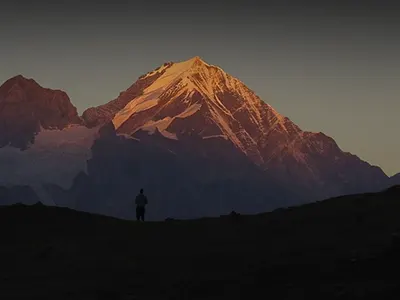Cheapest 8000m Peak to Climb: A Budget Mountaineer’s Guide to the World’s Tallest Mountains
High-mountain climbers respect the fourteen “eight-thousanders” – peaks with summits above 8,000 meters – as the ultimate “crown jewels” of mountaineering. These giants all lie in the Himalayan/Karakoram ranges, and ascending any of them means entering the infamous “death zone” above 8,000m, where oxygen is perilously thin.
Remarkably, eight of the world’s fourteen 8000m peaks sit (at least partly) in Nepal, making Nepal a prime target for high-altitude adventures. Despite Everest’s six-figure price tag, many of these peaks can be climbed for far less – in the range of USD 10,000–20,000 rather than $50–100k. For example, joining a group expedition on Mt. Manaslu (8,163m) often costs only $11,000–15,000 per person, a fraction of an Everest expedition.

This guide explains why climbers call these mountains the “cheapest 8000m peak to climb” by breaking down the costs and highlighting the most affordable 8000m summits in Nepal and beyond. The towering peaks of the Manaslu region (shown above) exemplify the challenge and allure of 8,000-meter climbing. In total, there are 14 such peaks worldwide, and climbers often dream of reaching the summit of the cheapest 8000m peak to climb.
Notably, Nepal alone contains eight of them (Everest, Lhotse, Makalu, Cho Oyu, Dhaulagiri I, Manaslu, Annapurna I, Kangchenjunga), each with its own terrain and expense. Contrary to popular belief, you don’t need $70,000+* to attempt one of these giants. With smart planning and local support, several 8000m expeditions are achievable for under $15,000–$20,000.
This budget mountaineering guide will walk through the major cost factors, ways to save, and which peaks offer the best value – so that your “cheapest 8000m peak to climb” can actually become a reality.
Understanding the Costs of 8000m Expeditions
Climbing any 8000m mountain is a complex operation, and costs can add up quickly. Major cost categories include permits, logistics, equipment, guides, oxygen, and insurance. By unpacking each, budget climbers can spot where to economize.
1. Major Cost Components
1.1 Permits and royalties
Most countries charge a steep fee to climb their 8000m peaks, often the single largest fixed cost. From September 1, 2025, Nepal raised 8000 m peak royalties. For peaks other than Everest, the fee is USD 3,000 (spring), USD 1,500 (autumn), and USD 750 (winter/monsoon).
Manaslu is an exception at USD 1,500 (spring), USD 3,000 (autumn), and USD 1,500 (winter/monsoon). Everest (south side) costs USD 15,000 in spring. In contrast, permit fees on the Chinese side of peaks like Cho Oyu or Shishapangma are much lower – one analysis notes China charges far less for peak permits than Nepal or Pakistan.
In Pakistan, the 2025 Gilgit-Baltistan fee schedule sets Broad Peak, Gasherbrum I, Gasherbrum II, and Nanga Parbat at USD 2,500 (summer), USD 1,800 (autumn), and USD 1,200 (winter) per foreign climber, while K2 costs USD 3,500 in summer. Always research the current permit costs for each country and season.
1.2 Logistics (transport, porters, base camp support).
Getting to base camp involves flights, jeeps, and high-altitude porters. A one-way flight to Lukla (the Everest area) now runs $300–$500, while a Kathmandu–Tumlingtar (for Makalu/Kanch.) flight is $200–$250. Road access can cut costs, as on Manaslu and Dhaulagiri (see below). Porters or yaks are hired to haul gear to base camp, typically costing $20–$40 per porter per day.
Transporting gear (food, tents, fuel) from Kathmandu to Lukla or Pokhara and then to base camp can run $1,000 or more. Campsite and dining tents, staff wages, and communications equipment at base camp also factor in – often 15–30% of the total budget. In the Karakoram, for example, one cost analysis found “base camp equipment and high camp fixed ropes” comprised up to 25% of expedition costs.
1.3 Oxygen and high-altitude gear
Nearly all commercial teams on 8000ers use supplemental oxygen. Expect $550 per bottle of oxygen with a summit push often needing 4–6 bottles per climber (so $3,000–4,000 just for your O2). Masks and regulators add another $900. Many teams also use oxygen for Sherpas and offer extra bottles for their support (at additional cost).
High-altitude clothing, boots, crampons, down suits, and hardware easily add $5,000–$8,000 to your expenses (though renting some gear in Kathmandu can cut this expense). Don’t forget glacier equipment, tents, ropes, and other mountaineering systems at each camp, which some operators include as a bulk cost. In aggregate, technical gear and oxygen can be 20–25% of an expedition budget.
1.4 Guides, Sherpas, and support team
Hiring experienced guides and Sherpas is a major cost – often the single largest expense. A western-led Everest expedition can cost $70,000–$75,000 (all-inclusive), whereas a Nepali Sherpa-led expedition might be closer to $40,000. For budget 8000ers, many climbers choose Nepali outfitters who run group trips.
Such teams still provide 1:1 Sherpa support during summit rotations, but save on Western guide fees. On peaks outside Nepal, local Karakoram operators also offer Sherpa-led expeditions; e.g., Pakistani guiding agencies will bundle Gasherbrum II with K2 training climbs at far lower per-person rates than Western companies.
1.5 Insurance and rescue.
Emergency plans are a must. Climbing permits often require proof of high-altitude rescue insurance. Helicopter evacuation coverage for mountainous regions can cost several hundred dollars (permitted rates).
1.6 Trip cancellation and medical insurance
This might add another few hundred to a few thousand, depending on age and policy. Compared to permits and guides, insurance is modest (<5% of total), but it’s essential for safety and sometimes mandatory.
2. Smart Ways to Cut Costs
Even with these expenses, savvy planning can trim the budget. For example, choosing a Nepali operator instead of a Western guide service often saves tens of thousands. (Data show the median all-inclusive Everest expedition with a Nepali-led team is $39,900, versus $51,000 with a Western leader.). Similarly, joining a group departure spreads costs – group climbs share fixed expenses.
On Manaslu, climbers joining a 4–10-person group typically pay $10,000–$15,000 each, whereas a solo climb can reach $18,000. Look for fixed-date group expeditions on lower-cost peaks to get these savings. Another cost saver is choosing peaks with road-accessible approaches.
For instance, Manaslu’s base camp trek starts at the village of Soti Khola (reachable by jeep from Kathmandu), eliminating the need for an expensive flight. Dhaulagiri’s (8,167m) approach goes up the Myagdi Valley, also accessible by road to Beni and then trek, saving travel costs.
In general, any 8000m expedition that skips a chartered helicopter or extra flights will be cheaper. Renting climbing gear in Kathmandu instead of buying new can save thousands. Similarly, scheduling your climb in the post-monsoon (autumn) season can halve permit fees (e.g., Nepal permits drop from $3,000 in spring to $1,500 in autumn), though weather windows are tighter.
Ultimately, combining these strategies – local operators, group logistics, road treks, and renting gear – is how climbers reach some 8000ers on budgets of only $15,000–$20,000.
3. Cheapest 8000m Peaks in Nepal (Ranked & Explained)
Below are the top candidates for budget climbers – Nepal’s 8000ers ranked roughly by affordability and ease. All cost figures are approximate expedition prices per person for a full-service climb.
3.1 Manaslu (8,163 m) – The Best Budget 8000er

• Cost: $10,000–$16,000 per person for a joint group. (Solo climbs can reach ~$18,000.)
•Access: Manaslu Base Camp is reached via the Budhi Gandaki valley. A jeep from Kathmandu to Soti Khola/Arughat gets you directly into the trailhead, minimizing expensive flights.
• Difficulty: Manaslu is considered the second easiest 8000m mountain after Everest because of the technically non-icefall routes. Slopes are fairly moderate and stable, and there are high chances of success compared to steep mountains.
Due to these reasons, Manaslu has been termed as being the cheapest 8000m peak to achieve in Nepal, such that the climbers achieve a safe and achievable 8000er, with a modest budget.
• Ideal For: First-time 8000m climbers. Manaslu’s straightforward logistics, guided Sherpa support (1:1 above Base Camp), and lower cost make it a classic “starter” eight-thousander. It gives climbers critical experience in the death zone without as much technical exposure as peaks like Annapurna or Makalu.
3.2 Lhotse (8,516 m) – Everest’s Affordable Sibling
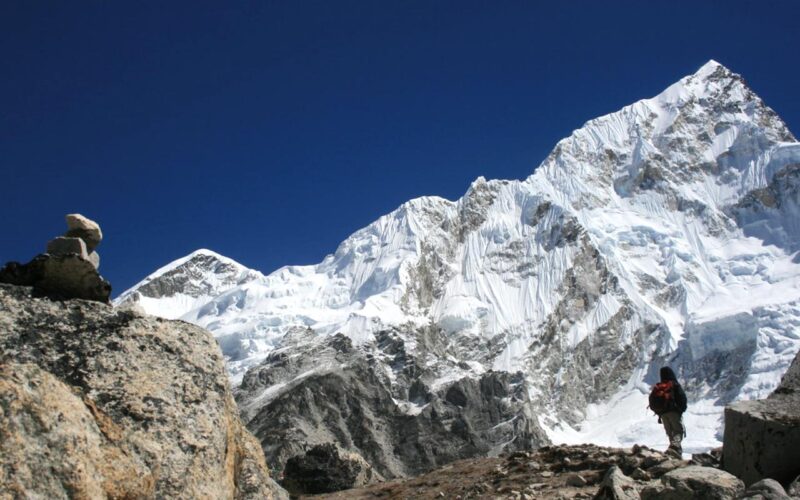
• Cost: $13,000–$20,000 per person, often done as a tandem with Everest logistics. For example, a 2025 all-inclusive package is listed at $18,500. (Group discounts can bring this toward $15k.)
•Access: Lhotse shares the first portion of its route with Everest up to Camp 3 on the South Col. Essentially, you climb Everest’s Khumbu Icefall and Western Cwm, then branch off toward Lhotse’s summit pyramid above Camp 3. This shared logistics means you only need one permit and one big setup for base camps – a big savings if added onto an Everest trip.
• Difficulty: Shorter than Everest, Lhotse avoids the treacherous Yellow Band but has some steep sections on the final pitches. It’s still very challenging, but experienced Everest climbers with full base camp experience find it more straightforward. In general, Lhotse could be considered a shorter and a little bit cheaper version of an Everest plus expedition.
• Ideal For: Climbers who have previously experienced Everest or wish to have an additional summit on the south side of Everest. Lhotse, coupled with Everest, is much cheaper per summit in comparison to two trips.
3.3 Dhaulagiri I (8,167 m) – Wild and Remote Adventure

• Cost: $12,000–$18,000 per person. (Local outfitters quote group climbs around $17,100.)
• Access: Dhaulagiri lies in Nepal’s remote west. The trek begins near Darbang in Myagdi District after a flight or drive to Beni. A newly built road up the Kali Gandaki valley streamlines access (though some trekking is still required). This road approach helps keep costs lower than older, fully remote expeditions.
• Difficulty: Dhaulagiri is steeper and more technical than Manaslu, but it lacks Everest’s bureaucracy and crowding. It’s still considered slightly cheaper than routes like Kangchenjunga. The normal route ascends well-tracked snow and ice, with fixed ropes on difficult sections. The lower number of clients also means more intimate Sherpa support.
• Ideal For: Strong climbers seeking solitude. Dhaulagiri’s wild Myagdi approach is scenically spectacular and far less crowded. Its costs and logistics are moderate compared to Everest, making it attractive for experienced alpinists not afraid of harder climbing.
3.4 Annapurna I (8,091 m) – Legendary but Dangerous

• Cost: $14,000–$20,000 per person. (Special packages list $17,100 as a starting price.)
• Access: Trekking through the Annapurna Sanctuary (via Chomrong to Base Camp) is a classic route. Approaches from Pokhara are straightforward (and road access reaches well up the valley). This ease partly explains why Annapurna was first summited in 1950.
• Difficulty: Annapurna has by far the highest fatality rate of any 8000m mountain – historically, about 32–33% of summiteers perish. Its avalanche-prone Southeast Face and corniced slopes make it extremely risky. While not the most technical 8000er, the objective hazards and steep gullies demand expert climbing.
• Ideal For: Very experienced mountaineers only. Its scenery – glaciers, valleys, and mountain vistas – is breathtaking, but Annapurna is strictly for those who can accept its dangers. In terms of budget, Annapurna is still cheaper than Everest (no icefall fees), but its cost is comparable to other hard Nepali 8000ers.
The central Annapurna massif from base camp (the Annapurna Sanctuary). While Annapurna I yields spectacular views, its steep snow faces and avalanche risk make it extremely challenging (the world’s deadliest 8000m peak).
3.5 Makalu (8,485 m) – Technically Challenging but Reasonable
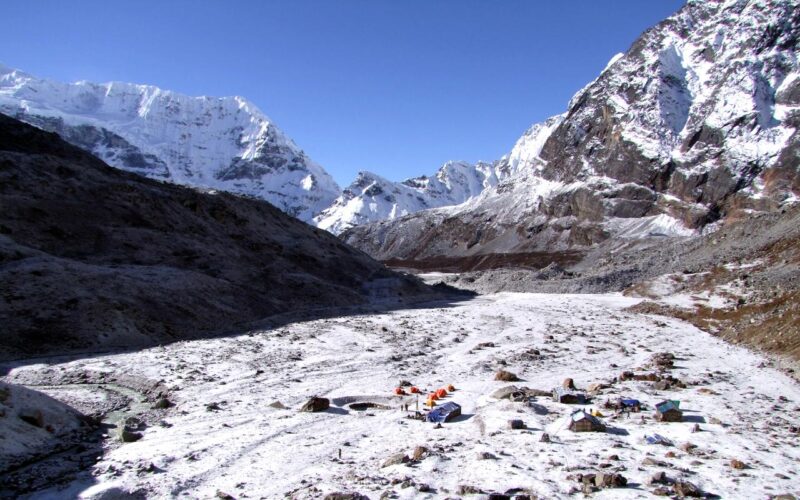
• Cost: $12,000–$17,000 per person in a group. (Group-join trips typically run $12k–$18k; solo expeditions can exceed $20k.)
• Access: Makalu’s base camp is reached via Tumlingtar in eastern Nepal. You must fly (or drive) from Kathmandu to Tumlingtar, then trek through Makalu-Barun National Park. This route is longer and more remote than the Everest region, but recently built airstrips and better roads have reduced costs slightly.
• Difficulty: Makalu is one of the steepest 8000m peaks. The standard route (Northwest Ridge) involves knife-edge ridges and fixed ladders. However, technical climbers rate it as easier than Everest’s summit difficulty. The payoff is an astonishing view from the top of Everest, Lhotse, and beyond.
• Ideal For: Skilled mountaineers seeking a true challenge with a bit more wilderness. Makalu’s expense is kept moderate by Nepal-based teams, and its summit panorama is unmatched.
3.6 Kangchenjunga (8,586 m) – Remote & Majestic

• Cost: $14,000–$22,000 per person. (Packages often run in the upper teens; western companies may quote higher.)
• Access: Far eastern Nepal is the setting. Climbing Kangchenjunga requires special Restricted Area Permits (RAP) and a long approach trek from Taplejung. Roads reach many villages in the area, but not Base Camp, so logistics involve multiple porter shifts. These factors add cost, though local operators can still offer shared expeditions.
• Difficulty: Kangchenjunga is technically and logistically demanding. Crevassed glaciers and steep mixed terrain define its route. The weather tends to be erratic. However, because fewer climbers go there, costs can be kept lower by sharing staff and gear.
• Ideal For: Endurance experts. If you want to be truly isolated on a big peak, Kangchenjunga’s remoteness and strict permit system offer that (and training in patience). It’s the highest peak accessible only through Nepal (no Tibetan side) and tests every aspect of high-altitude skill.
4. Other Affordable 8000m Peaks Outside Nepal.
Even beyond Nepal, several 8000m peaks present relatively low budgets:
4.1 Cho Oyu (8,188 m) – Nepal/Tibet Border
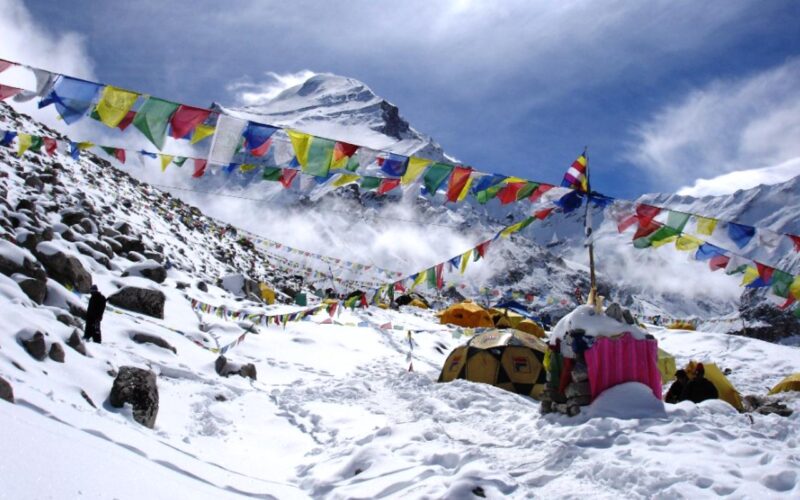
• Cost: $12,000–$18,000 per person (some operators advertise $15k–$25k).
• Access: The standard route is via Tibet/China. Climbing Cho Oyu involves a relatively short approach from Lhasa or Kathmandu (driving to the Chinese base camp). Chinese visa/tour fees and permits (often $800–900, included by outfitters) are typically cheaper than Nepal’s.
• Difficulty: Cho Oyu is considered to be the safest and easiest among the 8000m peaks. It has gentle and well-travelled slopes and a very high success rate. The most common route does not have any technical icefall to guide through.
• Ideal For: First-time 8000m climbers on a budget. Its relative simplicity and shorter climb time (about 6 weeks total) make it an excellent step up from 7000m peaks. Because it’s in Tibet, organizing with Chinese operators can also reduce permit and guide fees compared to Nepalese peaks.
4.2 Shishapangma (8,027 m) – Tibet’s Solo Peak
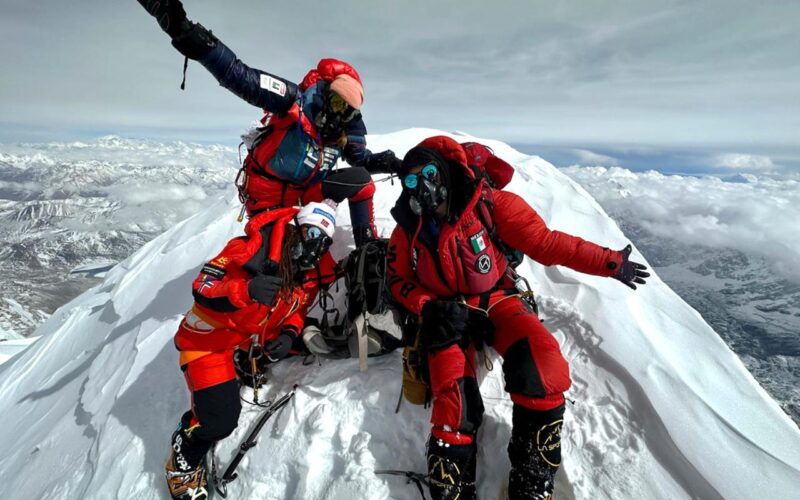
• Cost: $10,000–$15,000 per person if Tibet is accessible.
• Access: Shishapangma is entirely in Tibet/China. Its approach starts from Nyalam or Lhasa, taking about 4–5 days to Base Camp. Historically, China’s permit fees for Shisha have been very low (around $650), but in practice, Chinese operators often include permits in their package costs. In recent years, access can be restricted, and national park fees may apply, so costs fluctuate.
• Difficulty: Technically one of the easiest 8000ers. The normal route is a straightforward snow climb with no serious technical pitches. It does, however, require good fitness and often involves some hauling through the base camp from high altitudes.
• Ideal For: Climbers looking for an affordable, non-technical 8000m. It is the lowest of the fourteen peaks, which means slightly less time in the death zone. When Tibet permits are available, Shishapangma is often chosen as the least expensive Himalayan 8000m adventure.
4.3 Gasherbrum II (8,035 m) – Pakistan’s Budget Giant

• Cost: $8,000–$14,000 per person. (Some express-style expeditions advertise starting around $9,000 for full summit service.)
• Access: In Pakistan’s Karakoram, Gasherbrum II is surprisingly cheap due to generous Pakistani permit policies (flat $4,000 each as of 2025) and established base camp support. The Gilgit–Skardu region has robust trekking infrastructure, and many climbers combine it with Gasherbrum I or even K2 training.
• Difficulty: Considered one of the easiest 8000m climbs (along with Cho Oyu) in technical terms. The normal route has a moderate slope profile and an established network of fixed ropes, earning it a high success rate.
• Ideal For: Budget climbers seeking a reliable 8000m summit. GII’s well-equipped base camp and stable weather windows make it a great value. Many teams do an “express ascent” in just over 40 days, giving maximum efficiency for the money spent.
4.4 Broad Peak (8,047 m) – Karakoram Classic
• Cost: $9,000–$15,000 per person. (Group trips often start at $9,000 for climbing service.)
• Access: Broad Peak is just a few kilometers from Gasherbrum in the Baltoro region. Trekking to Concordia base camp (via Askole) is the same route as K2/Gasherbrums, spreading out the access costs. Shared logistics with other Pakistani 8000ers keep the price down.
• Difficulty: The climb is fairly straightforward, though it involves traversing glaciers and a snow ridge to the summit. Broad Peak is often done in combination with K2 training, making it ideal for climbers prepping for higher technical climbs.
• Ideal For: Fit climbers who want maximum altitude per dollar. Its terrain is moderate, and because it is near K2, it often sees full support infrastructure but fewer crowds. Broad Peak is a smart value climb on the way to K2.
5. Hidden Costs You Shouldn’t Ignore
Even after the big expenses above, several smaller costs can blow a budget if forgotten:
• Travel and visa: International flights to Kathmandu (or Islamabad/Lhasa) can vary widely. A low-cost airline ticket is ideal, but busy seasons may see airfares climb. Don’t forget the visa: Nepal tourist visa fees: 15 days USD 30, 30 days USD 50, 90 days USD 125.
Indian or Chinese visas (for expeditions) have their own fees. Getting to Kathmandu often involves multiple flights (e.g., Europe–Gulf–Kathmandu) that can add $800–$1,200 or more. Domestic flights (Kathmandu–Lukla/Pokhara/Tumlingtar) are $100–300 each.
• Communication and weather info: Satellite phone rental (required on most 8000m expeditions) costs $300/week. Hiring a private weather forecaster or expedition manager may add a few hundred. While optional, these services enhance safety.
• High-altitude consumables: Expect to spend on base camp supplies. In remote camps, food is included by your operator, but personal snacks (protein bars, energy drinks) and fuel (gas canisters) might be extra. Bottled oxygen refills can cost $50–$100 each if a fix is needed.
• Tips and miscellaneous: Tipping local staff (Sherpas, cooks, porters) is customary – often 10–15% of the total expedition cost divided among the crew. Also budget for emergency cash or medicine, and any unforeseen helicopter evacuations (which can run $5,000–$10,000 per flight unless covered by insurance).
• Insurance and rescue deposits: In Pakistan, climbers must pay a refundable $500 rescue deposit. In Nepal, a Refundable garbage deposit: USD 3,000 for most >8,000 m (Everest USD 4,000). This is separate from personal insurance.
• Liaison Officer (LO): required on major peaks; the LO cost (commonly USD 2,500–3,000) is billed by your operator as part of the expedition package, not included in the government royalty itself. These are not additional costs to the climber, but they are part of the permits detailed above.
6. Cost Comparison Table (Expanded)
| Peak | Height (m) | Country | Cost (USD) | Difficulty | Ideal For |
| Manaslu | 8,163 | Nepal | 10,000–16,000 | Moderate | First 8000er |
| Lhotse | 8,516 | Nepal | 13,000–20,000 | Hard | Everest climbers |
| Dhaulagiri I | 8,167 | Nepal | 12,000–18,000 | Technical | Experienced climbers |
| Annapurna I | 8,091 | Nepal | 14,000–20,000 | Very Hard (Deadly) | Experts only |
| Makalu | 8,485 | Nepal | 12,000–17,000 | Technical | Advanced climbers |
| Kangchenjunga | 8,586 | Nepal | 14,000–22,000 | Hard | Endurance experts |
| Cho Oyu | 8,188 | Nepal/Tibet border | 12,000–18,000 | Moderate (easiest) | Novice high-altitude |
| Shishapangma | 8,027 | Tibet | 10,000–15,000 | Moderate | Training/prep expedition |
| Gasherbrum II | 8,035 | Pakistan/China | 8,000–14,000 | Moderate | Budget climbers |
| Broad Peak | 8,047 | Pakistan/China | 9,000–15,000 | Difficult | Pre-K2 technical training
|
Note: Nepal’s new climbing permit fees took effect on 1 September 2025 (spring USD 3,000 / autumn USD 1,500 for most 8,000m peaks; Manaslu is the reverse). Pakistan’s 2025 schedule sets 8,000m permits at USD 2,500 (summer), USD 1,800 (autumn), USD 1,200 (winter), with K2 at USD 3,500 in summer.
7. Best Season to Climb Budget 8000ers
• Nepal (Himalayas): Pre-monsoon spring (April–May) and post-monsoon autumn (Sept–Oct) are the prime seasons. Spring has slightly more stable weather but higher costs and traffic. Autumn sees fewer storms and permit fees at half the spring rate (e.g., Nepali peaks $1,500 vs. $3,000).
• Pakistan (Karakoram): The climbing season is roughly June–August, when the monsoon bypasses the Karakoram. This period has long daylight and relatively lower wind on peaks like Gasherbrum and Broad. (Early June can be a bit stormy.)
• Tibet (Cho Oyu/Shishapangma): May and September–October are best. Summer monsoon affects the Tibetan plateau less than Nepal, but permits are more readily issued in pre- and post-monsoon windows.
Keep in mind: spring climbs often cost more due to higher permit fees and gear rental demand, but they usually have safer weather. Autumn offers cheaper climbs (and better vistas of the Karakoram) but shorter summit windows.
In Nepal, autumn permit fees are about half the spring rate — USD 3,000 in spring and USD 1,500 in autumn for most 8,000m peaks (Manaslu’s fees are the opposite: USD 1,500 in spring and USD 3,000 in autumn). Winter climbs exist, but costs drop even more (permits are lowest) – yet that is only feasible for very hardy teams.
8. How to Find a Trustworthy Budget Operator
Finding a reliable low-cost expedition operator is critical. Here are key tips:
• Check official registration: Nepali operators should be registered with the Nepal Mountaineering Association (NMA) and the Department of Tourism. Verify they have a current Government license for high-altitude expeditions. For Pakistan, look for KPO (Karakoram Permit Office) listings or Pakistan Alpine Club membership.
• Research experience and track record: Choose companies with experienced climbing leaders and good client feedback. Even low-cost teams should provide an experienced Nepali expedition leader (many have decades of high-altitude experience). Read independent reviews (e.g. on ExpedReview) to confirm past success and safety records.
• Shared vs. private logistics: Group departures with fixed dates are much cheaper than private teams. If you’re on a strict budget, opt for a group climb with shared tents, guides, and ropes. This is very common on Manaslu, Cho Oyu, Gasherbrum, etc.
• Beware “no-permit” or ultra-cheap offers: Any operator claiming to bypass permits or drastically undercut standard fees is dangerous and illegal. Governments require authorized licensed companies and officials (e.g., Liaison Officers). Steer clear of such scams – not only is it unethical, it can ruin your trip or get you banned.
• Ask for a detailed cost breakdown: A reputable company will provide an itemized quote: permits, oxygen, staff, meals, etc. Verify what is included (dining tents, emergency rescue, etc.) and what is not. Comparing apples to apples is key to spotting hidden upcharges.
In short, the “cheapest 8000m peak to climb” won’t do you any good if the operator cuts corners on safety. Prioritize well-reviewed, licensed agencies that demonstrate fair practices, even if it means paying a small premium over the absolute bottom dollar.
When comparing operators, verify key inclusions like the Liaison Officer (LO) cost, refundable garbage deposit, oxygen provisioning, and rescue plan. This ensures you’re comparing similar full-service packages rather than partial quotes.
9. Training for an 8000m Peak on a Budget
• Climbing an 8000m involves serious preparation. But it is no great cost to train, even without costlier expeditions.
• Progressive alpine climbs: Build your resume on 6000m–7000m peaks first. In Nepal, classics include Island Peak (6,189m), Mera Peak (6,476m), Baruntse (7,129m) or Himlung Himal (7,126m). These climbs teach you crampon, ice-axe, and basic high-altitude skills at low cost. A guided Mera Peak trek, for example, costs under $2,000.
• Treks for acclimatization and endurance: Long treks such as Everest Base Camp, Annapurna Circuit, or Manaslu Circuit. They enhance cardio health and subject you to trekking beyond 4,000-5,000m. They also condition your body to sleep high and carrying loads, which cannot be replaced with summit pushes.
• Stamina training: Regular cardio (running, cycling, stair-climbing) and weighted hill-trekking mimic base camp load carrying. Do multi-day hikes with a 20–25 kg pack. Altitude gyms (if available) or Hypoxico’s altitude tent can simulate lower oxygen.
• Mountaineering courses: Consider glacier travel and crevasse rescue courses in Nepal or the Alps. A 5–7 day introductory course (~$1,000) will teach rope team techniques, crevasse rescue, and high camp routines. These skills are life-saving on any 8000m peak.
• Mental prep and reading: Guides journey manuals, reports on expeditions, and last-summit accounts. Get to know the particular difficulties of your objective summit (i.e., avalanches on Annapurna, technical pitches on Makalu). Just basic home workouts and a good attitude will do.
Smart training is another form of “budget gear” – it makes you efficient on the mountain and reduces the risk of expensive failed attempts. Remember, time on the mountain is precious and costly; better-trained climbers make the most of it.
10. Conclusion
Summiting an 8000m peak doesn’t have to drain your savings. With smart choices, you don’t need $70,000 to live your high-altitude dream. Many eight-thousanders can be reached for $15k–$20k with local support.
Among these, Manaslu (Nepal) and Cho Oyu (Tibet/Nepal) stand out as the easiest and cheapest – ideal for a first 8000m. More technical climbs like Dhaulagiri I or Gasherbrum II demand experience, but they still cost far less than Everest while offering equally epic scenery.
It is advisable to always keep in mind that cheapness is never an alternative to safety. Select seasoned Sherpas, acclimate, and ensure the rescue. With a wise choice when choosing your peak, season, and operator, you will be able to make your 8000m experience cheap and successful.
FAQs
Q: What is the cheapest 8000m peak in Nepal?
A: Manaslu (8,163m) is regarded as the cheapest 8000m mountain to climb in Nepal. The average price of a guided trip is approximately between $10,000 and 16,000. The road approach is easier to access, is not highly technical, and has a high success rate, thus an option for first-time 8000m climbers.
Q: Is it possible to hike an 8000m mountain without oxygen?
A: Yes, but it is hard and risky. The supplemental oxygen used by the majority of the climbers is due to the fact that the air is very thin at that altitude. Very experienced mountaineers only attempt it. To be on the safe side, estimate 4 to 6 oxygen bottles per person.
Q What is the easiest, Manaslu or Cho Oyu?
A: The two are some of the easier 8000m peaks. Cho Oyu is softer and has a higher success rate, and Manaslu is cheaper and reachable through Nepal, as one does not have to obtain a Tibet permit.
Q: How long is an 8000m expedition?
A: The average time of expeditions is 6-8 weeks. This involves hiking to base camp, acclimatizing, and hiking to the summit. A Manaslu ascent would require approximately 45 days, whereas a Cho Oyu ascent would require approximately 40 days, since the approach is shorter.





